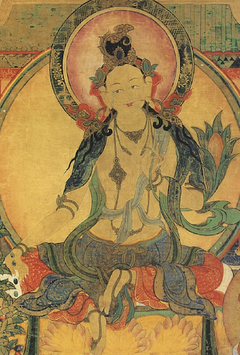Introduction to Vasudhārā
Introduction to Vasudhārā
by Stefan Mang
Vasudhārā (also spelled Vasudharā), whose name means “stream of gems” or “bearer of treasure,” is a Buddhist goddess associated with wealth, abundance, and spiritual prosperity.[1] She is often considered the consort of the wealth deity Jambhāla and is regarded as an emanation of the Buddha Ratnasambhava, the embodiment of generosity and prosperity among the five Tathāgatas.
While Vasudhārā’s qualities resonate with those of Hindu goddesses like Lakṣmī, within Buddhism she is understood not merely as a bestower of fortune, but as a goddess who supports practitioners on the path to awakening. Her blessings, though expressed through prosperity and well-being, are ultimately intended to remove obstacles and establish the stability necessary for spiritual practice.[2]
Veneration of Vasudhārā flourished throughout the Himalayan and Central Asian Buddhist world and holds particular prominence within the Newar Buddhist traditions of the Kathmandu Valley. There she is invoked in both monastic and domestic contexts—ensuring the success of households, merchants, and the wider community—and incorporated into the Saptavāra, a liturgical cycle of seven potent dhāraṇīs (incantations) recited on successive days of the week for purification, protection, and the accumulation of merit.[3]
Iconographically, Vasudhārā is typically depicted as a golden goddess, radiant with a yellow or gold complexion that embodies abundance and illumination. She appears either in a two-armed form—more common in India and Tibet—or in a six-armed form distinctive to Newar Buddhism. She sits in the posture of royal ease, her right leg extended and her left leg folded. In her six-armed Newar form, her upper right hand is raised in a gesture of praising the buddhas, while her upper left holds a manuscript of the Prajñāpāramitā Sūtra, linking her to the goddess of wisdom. Her four lower hands express her generosity in both spiritual and material realms: she holds a sheaf of rice, a cascade of jewels, and a treasure vase, while one hand displays the gesture of giving. Together, these attributes symbolize the harmony of agricultural fertility, material prosperity, and the perfection of generosity—virtues that sustain both worldly life and the path to awakening.[4]
Among the many prayers and practices dedicated to Vasudhārā, one of the most popular is the canonical text The Noble Vasudhārā Dhāraṇī—preserved in various forms in both Tibetan and Sanskrit—which teaches her sacred dhāraṇī, said to grant prosperity and wealth while also averting harmful spirits, demons, and disease.
While her gifts may appear worldly, Vasudhārā is ultimately revered as a support for the path to awakening. By easing material hardship and stabilizing the lives of practitioners, her blessings are understood to remove obstacles to spiritual practice, enabling the cultivation of ethics, meditation, and wisdom. In this way, she is venerated not merely as a giver of wealth, but as a compassionate bodhisattvā who nurtures the conditions for enlightenment.
Further Reading
Brown, Kerry L. “Goddess of Prosperity, Vasudhara: Material and Spiritual Abundance in the Kathmandu Valley,” Project Himalayan Art, Rubin Museum of Art, 2023. http://rubinmuseum.org/projecthimalayanart/essays/goddess-of-prosperity-vasudhara.
Bühnemann, Gudrun. “A Dhāraṇī for Each Day of the Week: The Saptavāra Tradition of the Newar Buddhists.” Bulletin of the School of Oriental and African Studies 77, no. 1 (2014): 119–136.
Handurukande, Ratna. Vasudhārādhāraṇī (kathā). In Buddhist and Pali Studies in honour of the Venerable Professor Kakkapalliye Anuruddha, (ed.) K.L. Dhammajoti and Y. Karunadasa. Centre of Buddhist Studies. The University of Hong Kong, 2009, 53–64.
Handurukande, Ratna. “The Buddhist Goddess Vasudhārā.” In Dhamma-Vinaya: Essays in Honour of Venerable Professor Dhammavihari (Jotiya Dhirasekera), Sri Lanka Association for Buddhist Studies (SLABS), 2005, 111–122.
Johne, Isabell. Vasudhārā: A Study of the Origin, Development, and Diffusion of Artistic Representations of the Buddhist Goddess of Prosperity in Their Cultural Contexts. Translated by Rachel Marks-Ritzenhoff. Aachen: Shaker Verlag, 2014.
Shaw, Miranda. Buddhist Goddesses of India. Princeton and Oxford: Princeton University Press, 2006.
Version: 1.0-20250624
